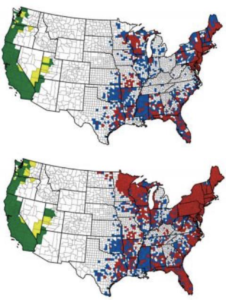Climate Change is Causing More Infectious Disease
Texas increasingly at risk
By Mirella Rogers
 As society grapples with COVID-19’s staggering destruction of human life and the global economy, we should examine the factors that created this pandemic.
As society grapples with COVID-19’s staggering destruction of human life and the global economy, we should examine the factors that created this pandemic.
Rapidly accelerating climate change is directly related to the increased spread of global disease because it lengthens animal and parasite reproduction seasons and expands tropical regions that are home to many contagious vector-borne (insect to human) diseases and zoonotic (or animal to human) diseases. For these reasons, mitigating climate change can help us avoid catastrophic epidemics like COVID-19.
Climate change is responsible for increased spread of mosquito-borne disease in Texas. Rising cases of Malaria, Chikungunya, West Nile (encephalitis and fever), Dengue, and potentially Zika are all caused by soaring mosquito populations. Shorter winters means more mosquito-borne disease outbreaks. Extreme summer heat and extended periods of humidity and rainfall allows for prolonged periods of mosquito breeding and survival. It also creates a longer time frame for these now larger mosquito populations to come in contact with parasites or other parasite harboring mosquitoes. Longer survival of more diseased mosquitoes and an expanded time frame for biting raises the risk of human infection. Texas is becoming more and more like the tropical regions that mosquito-borne diseases originate from largely because of climate change. Encroaching climates thus pose an alarming health risk to the southern United States and globally, including Northern Europe. These trends are clear in many contagious diseases and will alike only get worse.
The range to which ticks can spread across America is also growing at a distressing rate. Climate change has allowed ticks and the disease–causing germs they  carry to survive in many new now warmer climates throughout the Northeast. The larger geographic range of ticks is accompanied by longer reproduction periods that increase the number of ticks that can carry Borrelia, the germ responsible for many tick-borne diseases.
carry to survive in many new now warmer climates throughout the Northeast. The larger geographic range of ticks is accompanied by longer reproduction periods that increase the number of ticks that can carry Borrelia, the germ responsible for many tick-borne diseases.
Many states are now considered high-risk for Lyme, Anaplasmosis, Rocky Mountain Spotted Fever and other tick-borne diseases. Some of these diseases are life threatening if not seriously debilitating. Lyme diseases for instance, can cause permanent paralysis and neurological diseases including Parkinson’s disease.
Rats, whose ancestors caused the spread of the Bubonic plague, will be able to unleash more disease as climate change gets worse. Rat populations that would otherwise dwindle during winter months are now skyrocketing due to warmer winters replacing cold months that hindered breeding. This is a grave threat considering two rats can produce nearly a half billion offspring in three years.
Rats can cause human aliments just from exposure to their droppings yet rat-borne diseases will also become more common as a larger rat population can survive longer, in warmer weather, potentially increasing their exposure to disease causing bacteria including leptospira that causes leptospirosis, francisella that causes tularemia disease, and the Yesinia pestis germ that causes the plague. What’s more, rats carry fleas that also intensify during warmer winters and come in greater contact with Rickettsia bacteria which causes diseases including epidemic typhus and spotted fevers.
Bats carry many coronaviruses including Sever Acute Respiratory Syndrome (SARS), Middle East Respiratory Syndrome (MERS), and now COVID-19 (SARS-CoV-2) which has been traced to bats in Yunnan, China. Serious bat-borne epidemics are not new and have been linked to the 2014-2016 West African Ebola virus epidemic that killed over 11,000 and nearly tipper into a global pandemic.
Hot spots in which bat-borne diseases infect humans – Africa, Asia, South and Central America – are now spreading as tropic zones enlarge and the plant life bats feed on grow in more regions. Warmer winters will allow for longer mating periods for bats, prompting more intermixing of infected bats and producing a larger bat population to potentially interact with parasite and bacterial disease. These disease–causing pathogens are also heightened with longer periods of reproduction.
In combination with urbanization and transportation, even more bats harboring serious diseases will migrate to new densely populated regions and infect people that have never encountered these strains or developed immunity. This will present grave threats of the same nature as COVID-19. A hotter planet will, no doubt, give rise to more transmission of contagious diseases as urban development, human migration, and transportation expansion continue.
Finally, vaccine inequality and a lack of access to affordable health care in vulnerable populations throughout the globe will make those in poverty fall most victim to the spread of global disease.
1Claire AsherJan. 18, 2016, et al. “Lyme Disease–Carrying Ticks Are Now in Half of All U.S. Counties.” AAAS Science, 10 Dec. 2017, www.sciencemag.org/news/2016/01/lyme-disease-carrying-ticks-are-now-half-all-us-counties.